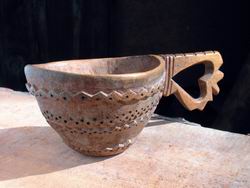Tibor Uhrín
Objects are made from certain materials by means of certain technological processes. The shape is dependent on both elements. Wood is reasonably flexible and is suitable for implementing a variety of technological processes that condition the shape of utilitarian objects. Some craftsmen still work only by using traditional methods and use entirely hand tools. They follow established traditions and seek to create a high quality product. They do not try to display their personality in the object. The changes are often very soft and very specific such as wood carving used for decorating wooden dishes or tools. These products are typical examples of preserving traditional technological methods in folk craft. Nowadays producers and craftsmen working with wood have the opportunity to choose from a wide range of available hand tools (mechanical and electric) and machines. The technology is often used for an artistic style and purpose in a certain style expression of the period. Perhaps for this reason, these new requirements imposed on product design initiated new technological innovations. Each craft process has gone through a long developmental period and has directly influenced the form as well as the decoration, e.g. turning, carving, veneering of furniture surfaces or bending parts. An excellent example of how finding a suitable technology can influence product design is the production of bentwood chairs. Michael Thonet made the traditional technology more effective by using a steel belt, various preparations and machinery. His patent was used for the industrial use of steamed bentwood. The most successful design ever was chair number 14. An important role was played by human capability and craft skill in the production of bentwood chairs. In the history of design, this product will probably remain as the most splendid example of a perfect understanding of design sense in furniture production. The innovation later became a tradition. On the other hand, members of the American religious community the Shakers (established in 1774 by Anna Lee) created mechanisms and tools themselves in order to increase productivity. This discovery is of greater importance than the discovery of round saw. The Shakers were very progressive and they were among the first to use all the new inventions in the world of technology. During the twentieth century only a few companies continued with the tradition of pre-industrial methods of specialized handcraft. Only during recent decades did interest in traditional techniques and craft products increase. A good result can be achieved by providing a balanced ratio of both “added values” – a good design and quality craft. Depending on experience, the creativity of the designer and their feeling for the craftwork and material so the craft character and traditional designation of the object was not lost by using current technological processes. Items made using craft techniques carry signs of individualism, are personal, and often display a regional character. In the future, craft will probably not stand in opposition to industrial methods of production but will rather complement it. The knowledge and abilities of craftsmen will have the task of solving problems of industrial production, in discovering the added craft value of products. And lastly, objects with individual character always have a longer life cycle because people create a more personal feeling towards them. The relationship of objects is one of the possibilities for reducing the rapid and continuous replacement of things – older for new ones, and thus slow down the increasing speed of the consumer society.
